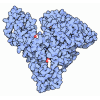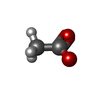[English] 日本語
 Yorodumi
Yorodumi- PDB-3e94: Crystal structure of RXRalpha ligand binding domain in complex wi... -
+ Open data
Open data
- Basic information
Basic information
| Entry | Database: PDB / ID: 3.0E+94 | ||||||
|---|---|---|---|---|---|---|---|
| Title | Crystal structure of RXRalpha ligand binding domain in complex with tributyltin and a coactivator fragment | ||||||
 Components Components |
| ||||||
 Keywords Keywords | TRANSCRIPTION / protein-ligand complex / DNA-binding / Host-virus interaction / Metal-binding / Nucleus / Polymorphism / Receptor / Transcription regulation / Ubl conjugation / Zinc / Zinc-finger / Activator / Phosphoprotein | ||||||
| Function / homology |  Function and homology information Function and homology informationpositive regulation of transporter activity / retinoic acid-responsive element binding / NR1H2 & NR1H3 regulate gene expression linked to triglyceride lipolysis in adipose / NR1H2 & NR1H3 regulate gene expression to limit cholesterol uptake / NR1H2 & NR1H3 regulate gene expression linked to gluconeogenesis / positive regulation of thyroid hormone receptor signaling pathway / NR1H2 & NR1H3 regulate gene expression linked to lipogenesis / Carnitine shuttle / retinoic acid binding / TGFBR3 expression ...positive regulation of transporter activity / retinoic acid-responsive element binding / NR1H2 & NR1H3 regulate gene expression linked to triglyceride lipolysis in adipose / NR1H2 & NR1H3 regulate gene expression to limit cholesterol uptake / NR1H2 & NR1H3 regulate gene expression linked to gluconeogenesis / positive regulation of thyroid hormone receptor signaling pathway / NR1H2 & NR1H3 regulate gene expression linked to lipogenesis / Carnitine shuttle / retinoic acid binding / TGFBR3 expression / positive regulation of vitamin D receptor signaling pathway / nuclear vitamin D receptor binding / Signaling by Retinoic Acid / DNA binding domain binding / RNA polymerase II intronic transcription regulatory region sequence-specific DNA binding / NR1H2 & NR1H3 regulate gene expression to control bile acid homeostasis / nuclear steroid receptor activity / LBD domain binding / locomotor rhythm / aryl hydrocarbon receptor binding / cellular response to Thyroglobulin triiodothyronine / regulation of lipid metabolic process / regulation of glucose metabolic process / Synthesis of bile acids and bile salts / positive regulation of cholesterol efflux / Synthesis of bile acids and bile salts via 27-hydroxycholesterol / Endogenous sterols / Synthesis of bile acids and bile salts via 7alpha-hydroxycholesterol / positive regulation of bone mineralization / response to retinoic acid / transcription regulator inhibitor activity / Transcriptional regulation of brown and beige adipocyte differentiation by EBF2 / retinoic acid receptor signaling pathway / cellular response to hormone stimulus / Recycling of bile acids and salts / NR1H3 & NR1H2 regulate gene expression linked to cholesterol transport and efflux / positive regulation of adipose tissue development / hormone-mediated signaling pathway / : / Regulation of lipid metabolism by PPARalpha / peroxisome proliferator activated receptor signaling pathway / regulation of cellular response to insulin stimulus / BMAL1:CLOCK,NPAS2 activates circadian expression / peptide binding / SUMOylation of transcription cofactors / Activation of gene expression by SREBF (SREBP) / transcription coregulator binding / response to progesterone / nuclear receptor binding / RNA polymerase II transcription regulatory region sequence-specific DNA binding / negative regulation of smoothened signaling pathway / SUMOylation of intracellular receptors / circadian regulation of gene expression / mRNA transcription by RNA polymerase II / Heme signaling / Transcriptional activation of mitochondrial biogenesis / Activated PKN1 stimulates transcription of AR (androgen receptor) regulated genes KLK2 and KLK3 / PPARA activates gene expression / Cytoprotection by HMOX1 / Nuclear Receptor transcription pathway / Transcriptional regulation of white adipocyte differentiation / RNA polymerase II transcription regulator complex / Activation of anterior HOX genes in hindbrain development during early embryogenesis / Transcriptional regulation of granulopoiesis / nuclear receptor activity / sequence-specific double-stranded DNA binding / : / nervous system development / HATs acetylate histones / MLL4 and MLL3 complexes regulate expression of PPARG target genes in adipogenesis and hepatic steatosis / double-stranded DNA binding / transcription regulator complex / Estrogen-dependent gene expression / sequence-specific DNA binding / cell differentiation / transcription coactivator activity / DNA-binding transcription factor activity, RNA polymerase II-specific / receptor complex / transcription cis-regulatory region binding / protein dimerization activity / nuclear body / protein domain specific binding / RNA polymerase II cis-regulatory region sequence-specific DNA binding / DNA-binding transcription factor activity / chromatin binding / regulation of DNA-templated transcription / chromatin / positive regulation of DNA-templated transcription / enzyme binding / negative regulation of transcription by RNA polymerase II / positive regulation of transcription by RNA polymerase II / protein-containing complex / mitochondrion / zinc ion binding / nucleoplasm / identical protein binding / nucleus / cytosol / cytoplasm Similarity search - Function | ||||||
| Biological species |  Homo sapiens (human) Homo sapiens (human) | ||||||
| Method |  X-RAY DIFFRACTION / X-RAY DIFFRACTION /  SYNCHROTRON / SYNCHROTRON /  MOLECULAR REPLACEMENT / Resolution: 1.9 Å MOLECULAR REPLACEMENT / Resolution: 1.9 Å | ||||||
 Authors Authors | Bourguet, W. / Le Maire, A. | ||||||
 Citation Citation |  Journal: Embo Rep. / Year: 2009 Journal: Embo Rep. / Year: 2009Title: Activation of RXR-PPAR heterodimers by organotin environmental endocrine disruptors Authors: le Maire, A. / Grimaldi, M. / Roecklin, D. / Dagnino, S. / Vivat-Hannah, V. / Balaguer, P. / Bourguet, W. | ||||||
| History |
|
- Structure visualization
Structure visualization
| Structure viewer | Molecule:  Molmil Molmil Jmol/JSmol Jmol/JSmol |
|---|
- Downloads & links
Downloads & links
- Download
Download
| PDBx/mmCIF format |  3e94.cif.gz 3e94.cif.gz | 64 KB | Display |  PDBx/mmCIF format PDBx/mmCIF format |
|---|---|---|---|---|
| PDB format |  pdb3e94.ent.gz pdb3e94.ent.gz | 45 KB | Display |  PDB format PDB format |
| PDBx/mmJSON format |  3e94.json.gz 3e94.json.gz | Tree view |  PDBx/mmJSON format PDBx/mmJSON format | |
| Others |  Other downloads Other downloads |
-Validation report
| Summary document |  3e94_validation.pdf.gz 3e94_validation.pdf.gz | 905.2 KB | Display |  wwPDB validaton report wwPDB validaton report |
|---|---|---|---|---|
| Full document |  3e94_full_validation.pdf.gz 3e94_full_validation.pdf.gz | 906 KB | Display | |
| Data in XML |  3e94_validation.xml.gz 3e94_validation.xml.gz | 12 KB | Display | |
| Data in CIF |  3e94_validation.cif.gz 3e94_validation.cif.gz | 16.8 KB | Display | |
| Arichive directory |  https://data.pdbj.org/pub/pdb/validation_reports/e9/3e94 https://data.pdbj.org/pub/pdb/validation_reports/e9/3e94 ftp://data.pdbj.org/pub/pdb/validation_reports/e9/3e94 ftp://data.pdbj.org/pub/pdb/validation_reports/e9/3e94 | HTTPS FTP |
-Related structure data
| Related structure data |  2p1tS S: Starting model for refinement |
|---|---|
| Similar structure data | Similarity search - Function & homology  F&H Search F&H Search |
- Links
Links
- Assembly
Assembly
| Deposited unit | 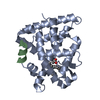
| ||||||||
|---|---|---|---|---|---|---|---|---|---|
| 1 | 
| ||||||||
| Unit cell |
|
- Components
Components
| #1: Protein | Mass: 27269.514 Da / Num. of mol.: 1 / Fragment: ligand binding domain (UNP residues 223-462) Source method: isolated from a genetically manipulated source Source: (gene. exp.)  Homo sapiens (human) / Gene: RXRA, NR2B1 / Plasmid: pET15b / Production host: Homo sapiens (human) / Gene: RXRA, NR2B1 / Plasmid: pET15b / Production host:  |
|---|---|
| #2: Protein/peptide | Mass: 1579.866 Da / Num. of mol.: 1 / Fragment: Nuclear Receptor box 2 (UNP residues 686-698) / Source method: obtained synthetically Details: The peptide was chemically synthesized. The sequence can be naturally found in Homo sapiens (human). References: UniProt: Q15596 |
| #3: Chemical | ChemComp-TBY / |
| #4: Chemical | ChemComp-ACT / |
| #5: Water | ChemComp-HOH / |
-Experimental details
-Experiment
| Experiment | Method:  X-RAY DIFFRACTION / Number of used crystals: 1 X-RAY DIFFRACTION / Number of used crystals: 1 |
|---|
- Sample preparation
Sample preparation
| Crystal | Density Matthews: 2.02 Å3/Da / Density % sol: 39 % |
|---|---|
| Crystal grow | Temperature: 293 K / Method: vapor diffusion / pH: 7.5 Details: PEG 4000, ammonium acetate, pH 7.5, VAPOR DIFFUSION, temperature 293K |
-Data collection
| Diffraction | Mean temperature: 100 K |
|---|---|
| Diffraction source | Source:  SYNCHROTRON / Site: SYNCHROTRON / Site:  ESRF ESRF  / Beamline: BM30A / Wavelength: 0.9797 Å / Beamline: BM30A / Wavelength: 0.9797 Å |
| Detector | Type: ADSC QUANTUM 315 / Detector: CCD / Date: Jul 18, 2008 |
| Radiation | Protocol: SINGLE WAVELENGTH / Monochromatic (M) / Laue (L): M / Scattering type: x-ray |
| Radiation wavelength | Wavelength: 0.9797 Å / Relative weight: 1 |
| Reflection | Resolution: 1.9→55.571 Å / Num. all: 19039 / Num. obs: 18558 / % possible obs: 98 % / Redundancy: 8.8 % / Biso Wilson estimate: 25.4 Å2 / Rmerge(I) obs: 0.062 / Rsym value: 0.062 / Net I/σ(I): 9.4 |
| Reflection shell | Resolution: 1.9→2 Å / Redundancy: 9.2 % / Rmerge(I) obs: 0.455 / Mean I/σ(I) obs: 4.3 / Num. measured all: 24155 / Num. unique all: 2630 / Rsym value: 0.455 / % possible all: 97.2 |
- Processing
Processing
| Software |
| ||||||||||||||||||||||||||||
|---|---|---|---|---|---|---|---|---|---|---|---|---|---|---|---|---|---|---|---|---|---|---|---|---|---|---|---|---|---|
| Refinement | Method to determine structure:  MOLECULAR REPLACEMENT MOLECULAR REPLACEMENTStarting model: 2P1T Resolution: 1.9→28.63 Å / WRfactor Rfree: 0.217 / WRfactor Rwork: 0.186 / Occupancy max: 1 / Occupancy min: 0.3 / FOM work R set: 0.844 / SU R Cruickshank DPI: 0.167 / SU Rfree: 0.148 / Isotropic thermal model: Isotropic / Cross valid method: THROUGHOUT / σ(F): 0 / σ(I): 0 / Stereochemistry target values: Engh & Huber
| ||||||||||||||||||||||||||||
| Displacement parameters | Biso max: 56.36 Å2 / Biso mean: 25.182 Å2 / Biso min: 13.81 Å2 | ||||||||||||||||||||||||||||
| Refinement step | Cycle: LAST / Resolution: 1.9→28.63 Å
| ||||||||||||||||||||||||||||
| Refine LS restraints |
| ||||||||||||||||||||||||||||
| LS refinement shell | Resolution: 1.9→1.949 Å
|
 Movie
Movie Controller
Controller



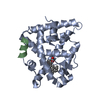
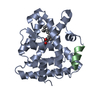

 PDBj
PDBj






